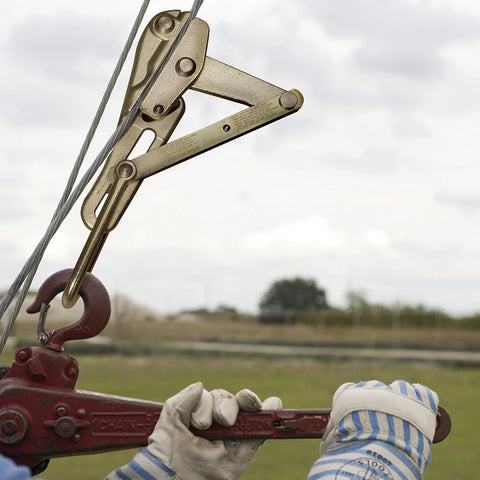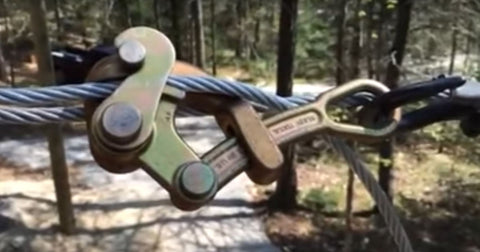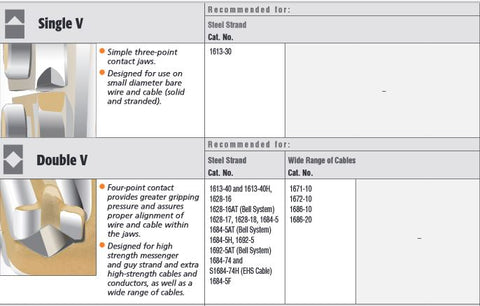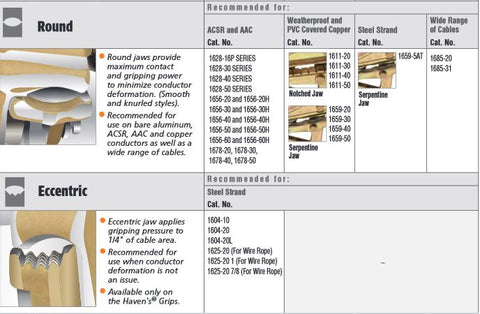History and Origin of Klein Tools Chicago Grips
Looking around you at the world will reveal that there are a lot of cables and wires hanging around over all of our heads. Power cables, data cables, telephone cables, and more power cables make up the bulk of the cables on most utility poles. And yes, birds are sitting on hot power lines in many cases. We see these cables a lot, and even see guys (in most cases) working on them, but we probably often don’t stop to think about how they got up there. Sure, the utility companies put them up there, but how? And what tools did they use? While there are likely many tools that go into running utility cables, Klein wire grips are probably one of the most widespread. Klein wire grips have been billed as an essential item for line workers all the way back to the 1920s and have a history going back even further. Given the tough job they have to do, they’re well made as you can sometimes see in restoration videos.
Given their place in American history as one of the main toolmakers for linesman going all the way back to the telegraph, it’s no surprise to learn that Klein invented wire grips and guards their patents on them closely. The earliest patent for wire grips that Klein advertises goes back to 1892, and they make the claim that they’ve been making them for more than 135 years – that’s all the way back to 1885 at least. So you might say they’re something of an expert on the manufacture of wire grips.
It’s also no surprise that Klein takes safety quite seriously given the potential for danger involved in working high above the ground with wires and cables. Each Klein wire grip is made in the USA and all are hand inspected, Magnaflux tested, test-pulled for the rated load and actuated to verify proper function. These wire grips are also made of the best available materials, drop-forged and heat treated to ensure a tough tool that can withstand the rigors of the job. Given the stresses they’ll be under, tough construction and testing are necessary just for basic safety.
Uniquely, Klein also stands behind their grips 100% as they’re also available for questions about the safe condition of their grips. It’s recommended to call them at 800-553-4676 or contact them by email at Hisupport@kleintools.com. Recommended preventative maintenance and thorough inspection before each use also ensures maximum safety. For this maintenance, Klein outlines six basic steps to care for your wire grip. Care of your Klein wire grip also will involve the use of the Klein Tools 25450 brush as well to clean out the surfaces that see the most action. You can also read the steps here and here or on the maintenance card included with each grip.
To further assist with safe usage, Klein also offers a couple other things. First, they provide a free service (contact info above) for recommending the correct grip for a given application based on a 3-foot sample of the cable you’ll be working with. Just contact them, send the cable and they’ll identify the correct grip to use. You can select the grip yourself too if you’re familiar with the jaw contour and the following three criteria: Type of wire or cable (ACSR, ACSS, AAC, Copper, Steel Strand), AWG or MCM (Diameter) of wire or cable, and Maximum safe load required. By using these three groups, Klein makes selecting the right grip relatively easy and they also organize the information really well in their catalogs.
There are three basic categories for wire grips: the Chicago Grip, the Parallel Jaw and the Haven’s grips. There’s also some bonus subcategories in those three families that are unique like the Guy Strand & EHS (extra high strength), Wide Range Grips, and Hot-Line Latch. You can see these subcategories as well as helpful cleaning information and common overhead applications.
The Chicago Grips (some Chicago grips for covered cable are referred to as “Smiley jaw”) are designed to be used with aluminum, copper, various types of coated wire and guy strand. The Chicago grips feature locking loop handles which allow the jaws to be locked open to easily position the wire. It’s really important to note here that some of the Chicago Grips, anything in the 1628 series, is custom order for specific jobs and can take up to at least 30 days to be made and shipped. It is also possible that two such Chicago grips could be used in the same job to preserve the cable integrity. You can view the entire line of Chicago Grips here, and we can also help you order the custom order Chicago grips, just beware again of the extended handling time in the event of a custom order.
Parallel Jaw Grips are made to pull a variety of cable types and sizes, they’re lightweight and relatively compact. This grip has a large aperture to allow use with large hooks on hoists, various winches and also tackle blocks. The Parallel Jaw grips come in round or double v jaw contours.
Haven’s Grips, also known as “pork chop” are designed as a light and compact grip where conductor deformation isn’t of concern. This grip distributes the gripping pressure to ¼” of the cable are, reducing stress. The Haven’s Grip 1625 series includes a swing latch that holds cable firmly.
Once you’ve selected the right grip and have inspected it for safe use, it’s a pretty simple operation. Essentially the cable is fed into the grip, it grips it, and then you connect it to the correct pulling machine with a hook and pull on it. You can see the wire puller here and some use of it here but the Haven’s grip in use can be seen here.
The wire grips made by Klein Tools are highly specialized tools for very unique jobs, but they’re pretty essential for any lineman. We carry the entire line of Klein wire grips, including the custom order Chicago grips. Keep in mind that some of these are special order, custom tools and may take time to produce, so when preparing to order one of these, it may be best to contact us first well ahead of time by email or phone: support@hausoftools.com or 310-870-3746.
Klein wire grips are a long standing tradition of excellence and they’re a tool that you can rely on to get the job done and done safely.



























Leave a comment